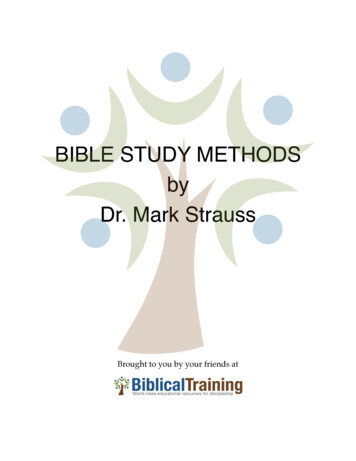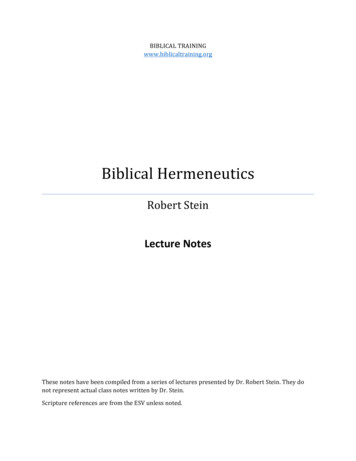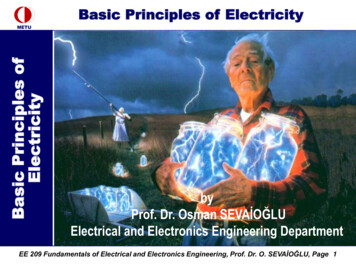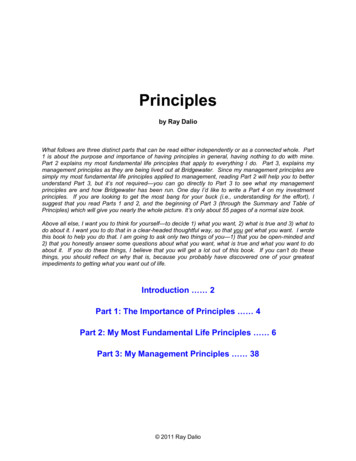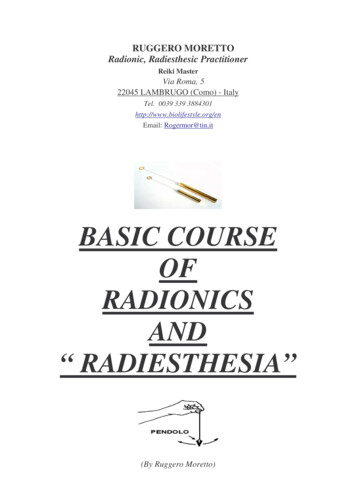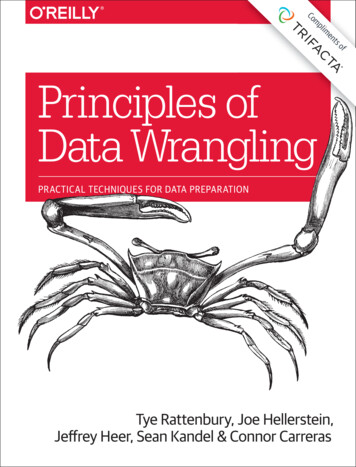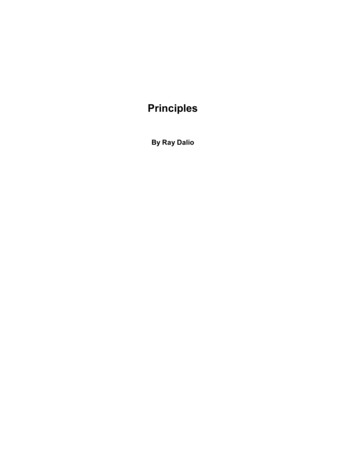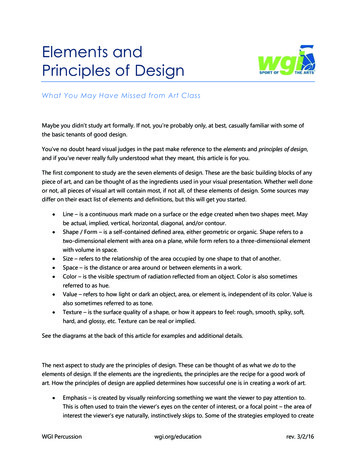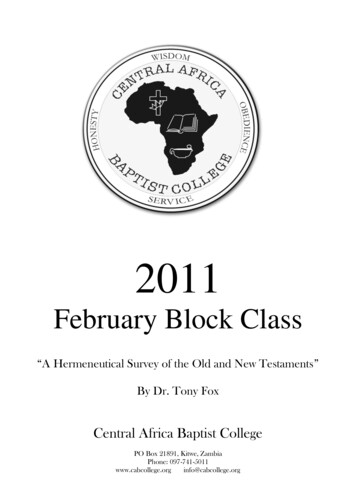
Transcription
2011February Block Class“A Hermeneutical Survey of the Old and New Testaments”By Dr. Tony FoxCentral Africa Baptist CollegePO Box 21891, Kitwe, ZambiaPhone: 097-741-5011www.cabcollege.orginfo@cabcollege.org
INTRODUCTION TO HERMENEUTICSIntro.Ralph Martin, Kingdom of the Cults – cult ―a group of people gathered about a specific personor person’s mis-interpretation of the Bible‖1.a.b.2.Poor principles of interpreting Scriptures is the foundation of every cultProper interpretation of the Bible is absolutely vital if we are going to understand the truth of theScriptures ourselves(1)Also vital to recognize and refute the error of othersProper interp. of the Bible is not always easya. E.g., 2 Peter 3:16—Paul’s writings are ―hard to understand‖i. Because of that, Peter says, ―the untaught and unstable distort them, as they do with therest of Scriptures, to their own destruction‖b. Bible interp. is hard work and careful attention to certain principles is absolutely essential if ourtheology is to be accurate and biblicalOutline:I.Definition of Hermeneutics the study of biblical interpretationA. Depends entirely on one’s belief about what the Bible is – 2 Tim. 2:16-17B. Depends on one’s belief about man’s depravity – Jer.C. Fuller def. the study of biblical interpretation recognizing the inspiration and sole infallibility ofGod’s WordII.Basic Hermeneutical SystemsA.Allegorical method1.Seeks for the hidden meaning (sometimes called ―spiritual‖ meaning) of the texta.Biblical words and events are interpreted symbolically, apart from their normaland natural sense2.Examples:a.1,000 years of Rev. 203.Danger 2 sidesa.The natural meanings of words and events can become irrelevant, discardingwhat God’s Word is saying and ignoring His intended meaningb.Meanings are given according to the whim of the interpreter(1)As created beings whose thinking has been corrupted, how can we trustthese meanings?(2)Also, who are we to give priority to our meanings rather than HisB.Natural Method (also called the Literal Method or the Grammatical/Historical Method)1.The normal, natural sense of the text is the real meaning2.3 elements:a.Grammar-- What is the normal, grammatical sense in the original language thatit was written (i.e., Hebrew and Greek)?b.History/culture--How would it be understood by someone living in that time inhistory and in that culture?Cent r al Afr ica Bapt ist Co llegePO BOX 21891 KITWE, ZAMBIA info@cabcollege.orgTel 26-097-741-50112
c.II.(1) illus.—I Cor. 7:1—not to ―touch‖ a womanLiterature—What literary genre was it written in and how do normal principlesof interpretation of that genre effect the meaning(1) illus.—―tree‖ in Num. 33:9 vs. Ps. 1:3 (interpreted figuratively because it ispoetry)(2) illus.—S. of S.—hair-like flock of goatsBasic Principles of HermeneuticsA.Interpret the passage literally according to its natural grammatical, historical and literary contextB.Interpret the passage with the help of other Scripture1.Because God’s Word is infallible, Scripture cannot contradict what is taught in anotherScripture on the same subject2.Other passages may help clarify the meaning of a certain passage3.Let clear passages interpret difficult ones instead of the other way arounda.illus.—Prov. 8 (Ps. 8:22?)C.A doctrine should not be built on a single passage, but should summarize all that the Scriptures asa whole teach on that subjectD.Do not read New Testament theology back into the O.T.1.Remember that God revealed Himself and His truth progressively through history2.illus.—Gen. 3:15Cent r al Afr ica Bapt ist Co llegePO BOX 21891 KITWE , ZAMBIA info@cabcollege.orgTel 26-097-741-50113
Divine Structure of ScripturesI.A.Old TestamentPentateuch1.Contentsa. Historical background of the covenantb. Demands of the covenanti. Lawsii. SacrificesIssue: HolinessResult: Desire for a perfect priest to offer a permanent sacrifice2.3.B.Historical & Poetical Books1.Contentsa. Optimismb. Disappointment2.Issue: Leadership3.Result: Desire for a perfect kingC.Prophetical Books1.Contentsa. Prediction: the Messiah, Day of the Lord, Restoration of Israelb. Proclamation: Present conduct should match future predictions2.Issue: Loyalty (chesed)3.Result: Desire for the perfect prophetSummary: The Old Testament ends with disappointment1.Unexplained ceremonies2.Unfulfilled prophecies3.Unsatisfied longingsKey Word: PreparationII.New TestamentA.1.2.B.1.2.C.GospelsFunction: Introduction of the person and work of Jesus ChristContentsa. Matthewb. Markc. Luked. JohnActsFunction: Proclamation of the person and work of Jesus ChristContents: Approximately 60 incidences of public and private evangelismEpistlesPaul’sa.b.c.d.e.f.g.h.2. General1.RomansCorinthian lettersGalatiansEphesiansColossiansPhilippians & PhilemonThessalonians lettersPastoral lettersCent r al Afr ica Bapt ist Co llegePO BOX 21891 KITWE, ZAMBIA info@cabcollege.orgTel 26-097-741-50114
a.b.c.d.e.D.1.HebrewsJamesPeter’s lettersJohn’s lettersJudeRevelationFunction: Consummation of Jesus Christ’s workKey Word:ManifestationSummary:The Word of God revolves around one person and His work: Jesus ChristCent r al Afr ica Bapt ist Co llegePO BOX 21891 KITWE , ZAMBIA info@cabcollege.orgTel 26-097-741-50115
THE SEQUENCE OF THE BIBLICAL COVENANTSIntroduction:1.Meaning of ―Covenant‖2.Old and New ―Testaments‖ Old and New ―Covenants‖Outline:I.Adamic (Edenic)—Hosea 6:7; Gen. 3:15a. Purpose Redemption of mankindb. Signsi. Substitutionary deathii. Covering of nakedness (shamefulness)II.Noahic—Gen. 9a. Purpose Physical preservation of man and his habitatb. Sign RainbowIII.Abrahamic—Gen. 12-22a. Purpose Selection of a family to inherit a national descendancy and landb. Sign Judgmental sacrifice (chs. 15, 22)IV.Mosaic (Old) —Exod. 19; Deuteronomya. Purpose Formation of a nation and demands of the Kingb. Signsi. Tablets of 10 commandmentsii. Shed bloodV.Davidic—2 Sam. 7; I Chron. 17a. Purpose Selection of a family for royal lineage leading to the Messiahb. Signsi. Perhaps Solomonii. Perhaps virgin birth (Isaiah 7)VI.New—Jeremiah 31a. Purpose To provide a successful replacement for the Mosaic Covenantb. Sign Lord’s Supper/Communion (Lu. 22)Conclusion:1.Our (the Church’s) relationship to the Abrahamic Covenant2.The future for the nation IsraelCent r al Afr ica Bapt ist Co llegePO BOX 21891 KITWE, ZAMBIA info@cabcollege.orgTel 26-097-741-50116
NT SURVEYINTERTESTAMENTAL PERIODIntro.The 400 years that separate the time of Nehemiah (and Malachi) from the birth of X are known as theIntertestamental Period (432 - 5 B.C.).--Called ―silent years‖ because God gave no revelation--But they weren’t quiet politically or socially--Many changes were taking place in the world to prepare the world for the arrival of it’s Savior --Gal. 4:4--Primarily 3 different forces were working during this time to prepare the way for X’s arrivalI. Greek preparation--intellectual cultureA. Before Alexander the Great (Greek), military strategy was not really used1. He created the Greek phalanx--a thin company of soldiers holding long spears2. Behind them were small auxiliary units3. The reason Al. the Great conquered the civilized world so quickly was simply because he won battles soquicklyB. Condensed outline of chronology1. Al. the Great rules the world--336-323 BCa. Forced Greek culture & language on all peoples (hellenization [fr. Ellhne§ Greek])(1) He allowed the Jews to worship freely because they welcomed him, having foreseen his comingfrom book of DanielCent r al Afr ica Bapt ist Co llegePO BOX 21891 KITWE , ZAMBIA info@cabcollege.orgTel 26-097-741-50117
(a) He acquired Israel in 332 BC2. Hellenistic Age--323-146 B.C.a. When Alex. Great died, left no sons(1) His empire was divided between his four generals(a) The families of two of these, the Ptolemies & Seleucids, fought for control over Israel for over acentury(b) When Ptolemies had control, the continued Alex’s policy of allowing them religious freedom(2) but Israel eventually came under the control of the Seleucids(a) Antiochus Epiphanes (ruled 175-164 BC) was a fanatic hellenizer[1] Tried to abolish Judaism[2] Desecrated Jewish temple by offering a pig on the altar and dedicating it to Zeus3. Roman Domination--146 B.C. onC.By hellenizing the world, Greek became the universal language1. Esp. common was a certain dialect called Koine Greek--NT2. Greek is one of the most precise languages ever in world’s historya. Philosophers used this language to discuss virtue, sin, righteousness, and other spiritual and moralattributes3. Therefore, by time of writing of NT, the phraseology and vocabulary in these areas was highly developedand just the right language to use to communicate spiritual truthD. Greek Philosophy1. Got the world thinking about immortality, life after death, good moral conduct, etc.2. Philosophers attacked idols and polytheism (many gods)E. Mystery Religions (could be compared to some cults today)1. Popularized ideas of redemption, atonement, shedding of blood, forgiveness of sins, and salvation2. Also idea that certain truth savesF. Great Greek Schools1. Dominated the educational worlda. Teachers such as Socrates, Plato, & Aristotle2. Tarsus had a famous schoola. No doubt influenced Paul’s training and thinking3. Because of these schools, Greek literature and ideas became widely knownII. Roman preparation--political organizationA. Organization was a necessity because the Romans were by nature an extremely unruly crowdCent r al Afr ica Bapt ist Co llegePO BOX 21891 KITWE, ZAMBIA info@cabcollege.orgTel 26-097-741-50118
B. Key to it’s organization were the legions1. Extremely disciplined fighting groups2. Greek phalanx didn’t work in rough terrain because the long spears could not be moved around quicklya. Romans used same method, only with short swords which cured the problem of rough terrain3. Backbone of the legions were centurions who disciplined men and led them in battleC. Result was the Pax Romana (Roman Peace)illus.--Compare with peacefulness in USSR & E. Europe during communism1. Strong, central, authoritative control, although oppressive, provides peacea. Although the average citizen did not like Roman domination, he enjoyed the peace2. Two centuries of peace starting near the time of X’s birth3. Gave X-tianity 200 years to expand quickly and spread the Gospel w/out hindrances of war and bordersD. Condensed outline of chronology1. Republic (basically democratic)--508 B.C.-30 B.C.2. Empire--30 B.C.-A.D. 476a. Golden Age: Augustus’ reign as first emperor--30 B.C.-A.D. 14b. Silver Age: A.D. 14-96c. Decline: 97-476E. Roman Law1. Enforced from Spain to Babylon2. Basically tolerant of all religions & customs as long as law and order was kept and taxes were paida. Much different than the sometimes offensive hellenization of Greek Empire(1) Greek Seleucids tried to destroy Jewish religionF. Communication Networks1. Land trade routes--paved and very well madea. Facilitated communication and, consequently, spreading of the Gospel2. Sea routesa. Rome had many ships in the Med.(1) Before, Med. was filled with piratesb. As a young man, Julius Caesar was kidnapped by pirates and held for ransom(1) Made an oath that when he came back to safety, he would crucify them(2) He was successful in completely removing piracy from the Med.(3) Therefore, seas were safeCent r al Afr ica Bapt ist Co llegePO BOX 21891 KITWE , ZAMBIA info@cabcollege.orgTel 26-097-741-50119
3. During the 1st 2 centuries AD, transportation and communication was better than for the next 17 centuriesa. Only this century, with the invention of the motor and air travel, surpasses it(1) But even now we don’t have anything like the Pax Romana(2) Therefore, difficult to spread Gospel in many places that were in Roman Empire, such asYugoslavia and Muslim countries around IsraelIII. Jewish Preparation--religiousA. As Paul says in Romans, Jews were entrusted with the oracles of God (i.e., OT)1. Jewish scribes were meticulous in copying OT Scriptures (much more so than NT scribes who did it foremployment rather than for religious reasons)B. Monotheism--The whole Roman Empire knew about the Jews’ monotheism1. This attracted those who had been influenced against polytheism by Greek philosophy2. For a while, Egypt had tried monotheism by worshipping the sun onlya. But this didn’t work; King Tut brought back polytheismC. Synagogues1. During the Babylonian exile, Israel was cut off from the Templea. They were surrounded by pagan religious practicesb. They lost their nation, but they still had the Pentateuch and the belief that they were God’s chosenpeoplec. So, they built small buildings called synagogues (Gr. sunagwgh ―gathering‖)d. Because they were away from their homeland and Temple, they concentrated on the OT Law, personalpiety, and prayer rather than sacrificese. After the Persians conquered Babylon and let the Jews travel back to Israel and to other places of theworld, the Jews took this synagogue method of worship with them2. Had to be at least 10 men to form a synagogue3. Would preach from OT3. Wasn’t always only Jews in synagoguesa. The ―God-fearers‖ were Gentiles who rejected polytheismb. They weren’t circumcised, but they recognized that what the Jews believed about their being only oneGod had to be truec. They were ignored by Jews until they became a proselyte(1) But to Paul, they were part of the audience--Act 13:14-164. These synagogues were natural meeting places where both Jews and some Gentiles could hear the GospelCent r al Afr ica Bapt ist Co llegePO BOX 21891 KITWE, ZAMBIA info@cabcollege.orgTel 26-097-741-501110
a. That’s why both Jesus and Paul utilized them so much5. Also, the synagogue’s emphasis on personal piety, prayer, and having a personal relationship with Godprepared the way for the GospelD. Septuagint (LXX)--Greek translation of OT1. Jewish legend says that 72 scholars were brought together to an island and produced this in 72 days2. Actually different parts of OT translated between 250-150 B.C.3. The millions of Gentiles and Jews who lived outside of Israel (the dispersion) could not read Hebrewa. But all could read Greek4. Created interest worldwide in Jewish religion & Scriptures5. Paul and other missionaries to Gentiles in Acts no doubt used LXXa. Thus it became the Bible for most believers in the early churchE. Messianic hope1. This was unique to the Jews2. By time of X’s birth, the golden age of the Romans’ democratic republic had passeda. Now there was a dictatorship3. For Greeks, their golden age was way back during the time of Socrates, Plato, and Aristotle4. But for the Jews, their golden age was in the futureF. Dispersion (Diaspora)--James 1:11. Began with Babylonian exile of Jews in 6th cent. BC2. By time of X’s birth, Jews had spread to every nation of civilized world3. Forced them to mix with Gentiles and not be so exclusive4. Gave rise to the synagogues because they were so far away from Temple in JerusalemG. Religious Groups1. Sadducees--The Greek world made its greatest impact in Israel through the Sadduceesa. Wealthy aristocrats who became the Temple-partyb. Were most sympathetic with Greek and Roman governmentsc. Although few in number, they had most political power andcontrolled the high priesthoodd. Rejected all religious writings except the Torah (Pentateuch)e. Rejected the idea of life after death (thus, ancient humanists)2. PhariseesCent r al Afr ica Bapt ist Co llegePO BOX 21891 KITWE , ZAMBIA info@cabcollege.orgTel 26-097-741-501111
a. Sads. were party of Temple; Phars. party of the synagogue(1) Sads. had strong contacts with government officials; Pharisees with the people(2) If Catholic, Sads. would be Pope (high-priest) and bishops; Phars. would be the common priests(3) Therefore, Phars. enjoyed the support of the people and influenced popular opinionb. They tried to reinterpret the Law by creating a hedge (expl.)c. When the Romans destroyed the Temple in AD 70, Phars. survived because, unlike the Sadducees,they weren’t tied to the Temple(1) Consequently, the Phars. are the fathers of modern Judaism3. Essenesa. A small, separatist group that secluded themselves in the deserts of Judeab. Stressed strict observance of the Lawc. But considered the Temple priesthood corrupt and, therefore, rejected most anything that had to dowith the Temple4. Zealots--more political than religiousa. Hated Roman-rule and used all means to try to shake it offb. Lu. 6:15--One of X’s disciples was a zealotc. Sicarii--radical zealots who would assassinate Roman soldiers5. Scribes--more occupational than religiousa. Copyists and ―experts‖ in the Lawb. Affiliated w/ the PhariseesH. Condensed outline of chronology1. Persian Period--538 BC-333 BC2. Alexandrian Period--333 BC-323 BC3. Ptolemy & Seleucid Period--323 BC-264 BC4. Maccabean Period--165 BC-63 BC5. Roman Period--63 BC- end of empireCent r al Afr ica Bapt ist Co llegePO BOX 21891 KITWE, ZAMBIA info@cabcollege.orgTel 26-097-741-501112
NT SURVEYGOSPELSIntro.Purpose: To introduce person & work of Jesus, the MessiahThis includes:proving to Jews that Jesus’ is Messiah prophesied about in OT to Jews (esp. Mt. & Lu.)proving to Gentiles that Jesus is only viable Savior (esp. Mk. & Jn.)Theme: The person & work of Jesus XI. Meaning of ―Gospel‖--euaggelia, euaggelizomai a good proclamation, good newsA. OT ends with disappointment, despair, and hopelessness of man’s sinB.NT begins with the solutiona. Solution is Jesus X, His person & work (i.e., who He is & what He did)C.2 parts to the idea of ―Gospel‖1. Content of the Good News2. Proclamation of the Good NewsII. Synoptic GospelsA. Synoptic from sunoptiko§ something seen together1. Refers to Mt., Mk., & Lu. because so much of their content is about the same events in Jesus lifea. Jn covers almost completely different events of X’s life than other three because he wrote his Gospelmuch later and probably had access to all three2. ―Synoptic Problem‖--not really a problem, but liberal theologians want it to be onea. In recording the same events of Jesus’ life, there is much that the 3 agree onb. But there is also much that they don’t agree on(1) Next year we will deal with this in detail in NTIc. For now, 4 factors that solve most of these problems:(1) Personalities of the writers(2) Purposes and audience aims for which books were written(3) Each is a Greek translation of what Jesus said in Aramaic(4) Agency of the H.S.--Jn. 14:26MATTHEWI. Unique contents--(important factor in discovering emphases of the Gospels)A. 130 quotes & allusions from the OTCent r al Afr ica Bapt ist Co llegePO BOX 21891 KITWE , ZAMBIA info@cabcollege.orgTel 26-097-741-501113
1. Quotes from 25 books of the OT2. Refers to 40 OT prophecies about the Messiah3. 410 vv. that appear in no other Gospel4. 40 parables--10 unique to Mt.5. 20 miracles--3 unique (healing of two blind men, deliverance of the mute demoniac, finding tax money infish’s mouth)II. StructureA. Introduction--1:1-17--a genealogy1. Only other gen. is in Lu. 32. 2 distinctives about Mt.’s genealogya.Only book in entire Bible to start w/ one(1) Suggests right away that the descendancy of this Person is an important element of Mt.’s overallpoint (or theme)b. Other distinctive is the way he singles out Abraham & David at beginning(1) Implies that out of all the people in this genealogy, Mt. wants to draw our attention to the fact thatJesus was a descendant of these two men(a) Because He is a descendant of Abraham, He qualifies to be the ―Descendant who will bless allnations‖ that God promised to Abe(b) Because He is a descendant of David, He qualifies to be the descendant of David whom Godpromised would be the King of Israel whose kingdom will be eternal[1] Phrase ―Son of David‖ used 8 times in Mt.[a] Only 3x in Mk. & Lu., none in Jn.(2) So, Mt. begins his Gospel, as well as the NT, with this genealogy that demonstrates the racial androyal pedigree of the One whom he is going to write about3. Another thing this gen. accomplishes is that it provides an immediate link fr. the NT to the OTa. NT is not disconnected from the OT, but rather an explanation and expansion of itB. Conclusion--Mt. 28:18-201. dunami§ power in sense of ability2. exousia power in sense of authority3. This is an assertion of His absolute, comprehensive authority over everything that has been given to HimCent r al Afr ica Bapt ist Co llegePO BOX 21891 KITWE, ZAMBIA info@cabcollege.orgTel 26-097-741-501114
by the One who has the right to give it: GodIII. Theme--Although most conservative scholars simply state it as something like ―The Kingship (Messiahship) ofX‖, I think this idea of authority that the book ends with needs to be brought out moreA. I would say, ―The royal authority of Jesus Christ‖1. In other words, Mt. uses the idea of X’s being King as a subordinate idea that supports this truth that Hehas all authorityIV. OutlineA. Introduction of the King--chs. 1-41. His genealogy2. His birth3. Jn. B’s ministry4. Jesus’ baptism--voice from heaven--this is the Son of the ultimate King5. Temptation--first demonstrates authority over Himself6. Beginning of His ministryB. Manifesto of the Kingdom--chs. 5-7 (Sermon on the Mt.)1. These are principles of the Kingdoma. What you have to do to enter itb. What you have to do to live as a proper citizen of itC. Miracles--chs. 8-9--authority of the King over disease, death, demons, and nature (calms storm)D. Commission of 12 disciples--ch. 10--delegation of His authority to His kingdom messengers1. 10:12. Look at the message He told them to proclaim--10:7 the kingdomE. Opposition to the King--chs. 11-121. From inside--uncertainty of Jn. the B.--11:1-22. From outside--the Pharisees challenges--ch. 12F. Parables--ch. 13--Description of the Kingdom present and futureG. Continuation and intensification of opposition intermingled with miracles--chs. 14-171. As the challenges to X’s authority increase, so do the miracles demonstrating X’s authoritya. In fact, in this section the narrative alternates basically from challenge to miracle(1) Jn. the B. beheaded--ch. 14(2) Jesus feeds 5,000 and walks on water(3) Pharisees accuse Jesus’ disciples of violating the traditions of the elders--ch. 15Cent r al Afr ica Bapt ist Co llegePO BOX 21891 KITWE , ZAMBIA info@cabcollege.orgTel 26-097-741-501115
(4) Jesus feeds 4,000(5) Phars. & Sadducees demanded a sign from heaven to prove His authority--ch. 16(6) Jesus gives a tremendous sign from heaven of His authority in ch. 17, but not to Phars. & Sadds.(a) Only to his 3 chief discs., Peter, James, and John(b) He was transfigured before them (i.e., He was shown to be God)(c) He was recognized by Moses the law-giver and Elijah the chief of Israel’s prophets(d) And, to top it all off, that event ends with God saying, ―This is my Son with whom I am wellpleased. Listen to Him!‖[1] I mean, you talk about a sign of authority! You can’t do any better than that!2. Also in this section, X predicts what will be the culmination of the Jewish relig. leaders’ oppositiontoward Him--16:21a. The highest degree of opposition is to kill someoneb. That will be the degree of the Jewish relig. leaders’ opposition of their own Messiah(1) Why? Because before Him, who had the authority? They did.H. Relations in the Kingdom--ch. 18--much of it has to do with how to deal with a brother who sins against youI. The Jews’ rejection to X’s royal authority--chs. 19-221. 21:23; 23:37--X informs them that they have thrown away their opportunityJ. Olivet discourse--chs. 24-25--assertion that He will still be King at the end of the ageK. Final opposition of the Jews (murder) followed by incontestable triumph of the King who has all authority1. While demonstrating His superiority over His murderers, He demonstrated His superiority over death2. And so His claim near the end of the Gospel--He has all authority, even over death3. And the Gospel actually ends with a command--28:19-20a. This command is based on the authority He has just demonstrated for the last 28 chs.--28:18B. Mt.’s Gospel ends with a challenge to every reader1. Either the reader will admit that Mt. has proved that Jesus does have this absolute, universal authority andthe reader will submit to Him as his King2. Or the reader will reject what Mt. wrote, deny that Jesus does have such authority, and refuse to submit toHim as his KingCent r al Afr ica Bapt ist Co llegePO BOX 21891 KITWE, ZAMBIA info@cabcollege.orgTel 26-097-741-501116
MARKI. Unique Contents & EmphasesA. No account of Jesus’ birth or infancyB.Only one major discourse (ch. 13)--37 vv. compared to same material in Mt. which is 97 vv.C.Although contains many quotes and allusions to OT, only about half as many as Mt. & Lu.D. Uses least literary Greek of perhaps all NT writersE. euqew§ & euqu§ 42x--more than all other NT books combinedF. Uses historic present and imperfect tenses with verbs much more than others1. These two represent an action that is continually going on2. Jesus’ actions, rather than His sayings, dominate Mk.’s Gospel3. The aim of the writer is to impress his readers with the rapid, ceaseless energy of the SaviorG. Miracles--records 18 out of 351. Gives more space to miracles per page than any other Gospel writer2. 2 unique (deaf & dumb man healed in ch. 7; blind man healed at Bethsaida)H. Focuses on events of Passion week (Jesus’ suffering) more closely than any other period of X’s lifeI. 8 allusions to Isaiah’s ―Servant of the Lord‖--1:11; 2:20; 3:23-27; 8:31; 9:12; 10:45; 14:24; 15:51. Stressed much more than other Gospels2. In Roman Empire pop. about 100 million; 60 million were slavesa. Perhaps this was his primary audience aim (masters could relate to)b. Most treated very cruelly by Romans and suffered much while servingc. Tradition and history suggest that Mark wrote it while in Rome3. Reflects same emphasis found in I Pet. where also several allusions to Isaiaha. Out of all apostles, Mk. most closely associated with Peter(1) In stories where Peter is involved that Mt. & Lu. also comment on, Mk. provides more details4. Isa. 53:1-12--Notice these elements about the great Servant:a. He would be despised & rejected by men--v. 3b. He would be oppressed, afflicted, and judged--vv. 4-9c. After He suffers He will see light (ref. to res.)--v. 11ad. He will justify many and bear their sins--v. 11b-12e. Entire ch. is under heading of believing a message--v. 1f. This is a suffering servant, i.e., His great service for others will be surrounded with suffering5. Mk. 8:31; 9:12--Mark emphs. not only suffering, but rejection (like in Isa. 53)Cent r al Afr ica Bapt ist Co llegePO BOX 21891 KITWE , ZAMBIA info@cabcollege.orgTel 26-097-741-501117
a. Drew Conley said major motif in Mk. was X’s being forsaken (rejected)(1) 1st rejected by Jewish relig. leaders(2) Then by Jewish people(3) Then by his own disciples(4) Finally by God Himself6. 10:45--2 major motifs in Marka. Serviceb. Suffering (while serving [benefitting] others)II. Literary StructureA. Introduction--1:1-31. Starts quoting Isaiah by the second versea. Immediately Mk. wants us to be thinking about Isaiah’s writingsB. Conclusion1. Many conservative scholars do not thing vv. 9-20 were part of original writing for several reasons:a. Not contained in the oldest and most reliable copies of Mk.b. These vv. has a different writing style than rest of Gospelc. different vocabularyd. different contente. Good men differ on this, e.g., Tenney seems to argue for accepting them(1) I personally don’t think they are authentically Mark’s2. If so, that means that the Gospel really ended with 16:1-8a. Account of women going to tomb and meeting angel--vv. 6-8(1) 2 elements:(a) Testimony of the angel concerning Lord’s res.(b) Fear of the women--this Gospel ends in fear[1] Somewhat ironic: nobody feared the power of a slave(c) The fact that a divine being testifies that this One rose from the dead combined with the womenbeing afraid demonstrates that this was no mere human slave[1] Unlike any other slave, He is special--He is the ultimate Servant of the Lord prophesiedabout in Isa.[a] Throughout Mark’s Gospel is motif on X’s authority (although not main theme likeMt.’s)[b] In the Roman empire, many servants were given authority by their masters over certainCent r al Afr ica Bapt ist Co llegePO BOX 21891 KITWE, ZAMBIA info@cabcollege.orgTel 26-097-741-501118
matters or over other slaves[c] And at the end of Mk’s Gospel we see that Jesus is a Servant with such tremendousauthority, that He even has authority over deathIII. ThemeA. Tenney, ―The tragedy of the Gospel was an inevitable part of His service to men and of His redemption ofthem‖B.Theme: The Suffering Servant (of Isaiah)IV. OutlineA. The Arrival & Preparation of the Servant--1:1-13B.The Ministry of the Servant--1:14-ch. 10C.The Suffering of the Servant--ch. 11-15D. The Triumph of the Servant--ch. 16LUKEI. Unique Contents & EmphasesA. Many more unique accounts than either Mt. or Mk. (approx. 93)1. Examples: Jn. the B.’s parents & birth, angel appearing to Mary & Mary’s praise to God, angels appearingto shepherds, Simeon’s prophecy about X in the Temple, sinful woman anointing Jesus’ feet, story ofMary & Martha, conversion of Zacchaeus, conversation with two disciples on road to Emmaus, Farewellinstructions and ascensionB.Major motif (emphasis) on universality of Gospel1. i.e., recognition that not only the Jews, but Gentile too are a part of God’s planC.Minor motif on disadvantaged (poor, women, children, sinners, criminals, Gentiles)1. Supports Luke’s major motif on X’s perfect humanity2. Luke uses these motifs to show how Jesus, as the perfect man, makes up for the deficiencies belongingto those who are disadvantaged in this human race)D. Makes much greater use of allusion to O.T. rather than directly quoting OT or using ―that it might befulfilled‖ phrase of Mt.II. Literary StructureA. Introduction1. Luke gives a literary prologue t
Central Africa Baptist College PO BOX 21891 KITWE, ZAMBIA info@cabcollege.org Tel 26-097-741-5011 2 INTRODUCTION TO HERMENEUTICS Intro. 1. Ralph Martin, Kingdom of the Cults – c
